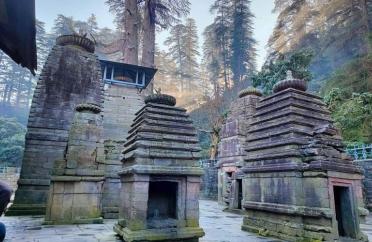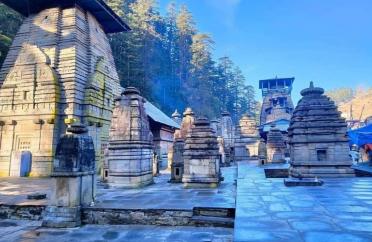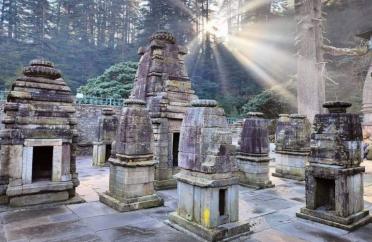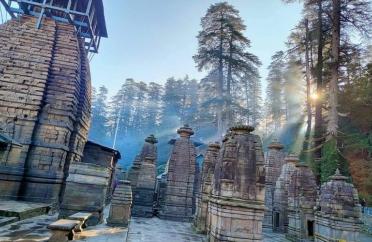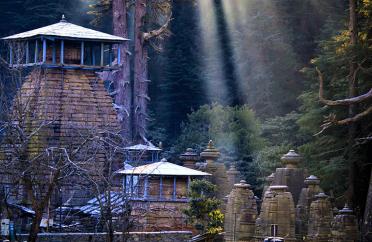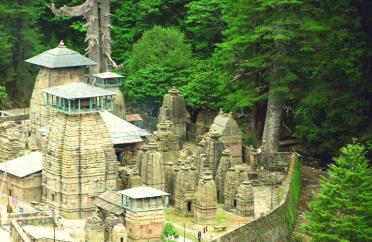The Hindu pilgrimage town of Jageshwar sits as though frozen in time, perched at an altitude of 6135 feet.
Believed to be the abode of one of the twelve ‘Jyotirlingas’, it is one of the most important religious places for Hindus in Kumaon. Legend has it that Lord Shiva would come down from his abode and meditate here, surrounded by the thick Deodar forest. Jageshwar consists of a cluster of 124 exquisite stone carved temples dating between the 8th and the 13th Century. It is said that originally four hundred temples existed here but only a quarter have survived.
Jageshwar is located in the narrow Jat Ganga river valley. Snow-capped mountains form a perfect backdrop for this beautiful temple site. Caressed by the two streams, Nandini and Surabhi, which converge near a sacred spot in the temple complex, this site is a visual treat.
The mystical and tranquil setting of Jageshwar makes it an ideal holiday destination to explore, meditate and rejuvenate the body and mind.
Many years ago, Jageshwar used to be a pilgrim halt en-route to the famous Kailash-Mansarovar pilgrimage. Today, easy access from Delhi via train to Kathgodam and then just a four hour drive along beautiful Kumaoni villages and deodar forests makes it a great off-the-beaten track kind of destination. For travellers not having the time to go way up to the Badrinath and Kedarnath dhams, it is a convenient option. Jageshwar is also a great stopover for Himalayan jeep safari trips.
A concordance between the primordial magnificence of Nature, the spiritual essence that is intrinsic to Jageshwar and the simple human habitats make it a must-visit. There are various temples in Jageshwar which make it a famous temple town in Uttarakhand. There is an immense amount of history and culture in the town which makes it a renowned pilgrimage site apart from being a famous site for trekking and avifauna.
TEMPLES
Shiva Temple in Jageshwar: Shiva is addressed by diverse names. Jageshwar is only a version of Yogisvara (Lord of Yogis). Most of the shrines at Jageshwar portray Shiva with his varied names like Mahamrityunjaya, Nilakantheshvara, Dandeshwar etc.
The other temples are dedicated to Surya (the Sun God), Navadurga (nine manifestations of the goddess Durga), Kalika, Pushtidevi and Kubera. Built by professional builders in the name of Shaivism, they belonged to the Lakulish sect. The jyotirlinga at Jageshwar is visited by thousands of Shiva devotees who come to offer prayers during Shivratri.
Throughout India’s history, religion has played an important part in Indian culture. Out of all the religion in India, Hinduism can be traced to prehistoric times. Majority of hindus worship Lord Shiva. Jageshwar is the most pure land where it is said that Lord Shiva lived meditate in the Himalayas, Uttarakhand.
The state of Uttarakhand is known as ‘Dev Bhoomi’ i.e. the Land of Gods, where one finds temples almost everywhere depicting stories of different gods, deities and many such holy souls. Many ardent Hindus wish to visit the beautiful Dev Bhoomi and bow before the lord. Many temples which were constructed many years ago are still kept in perfect shape. The most commonly visited temples are Jageshwar, Badrinath, Kedarnath, Yamunotri and Gangotri.
Of all the major Hindu pilgrimages in the Uttaranchal, Jageshwar Temple is the most important for Shiva worshipping. The temples of Yamunotri, Gangotri, Kedarnath and Badrinath together constitute the Char Dham Yatra which is of great importance to the Hindus. Pilgrims from all over the world visit these places especially to worship the holy gods and enjoy the Himalayas. Rudranath Temple, Badrinath Temple, Kedarnath Temple, Naina Devi Temple, Mansa Devi Temple, Madmaheshwar Temple, Yamunotri Temple, Neelkanth Temple are some of the most important Temples of Uttarakhand.
Jageshwar temples: Jageshwar is a Hindu pilgrimage that is located in the Almora district in Uttarakhand. Jageshwar Temple is especially dedicated to Lord Shiva among the beautiful Deodar trees. The bevy of Jageshwar Temple illustrates ancient culture and beautiful historic designs. The deodar trees and the Jata Ganga which flows through the temple lends to the beauty of the place. The place also acts as a meditation center due to the calm, fresh and beautiful environment surrounding the temple. The bevy of Jageshwar Temples includes Dandeshwar Temple, Chandi-ka-Temple, Jageshwar Temple itself, Kuber Temple, Mrityunjaya Temple, Nau Durga Temple, Nava-grah Temple, Pyramidal Shrine and the Surya Temple. Dandeshwar Temple and the Mrityunjaya Temple are known as the oldest and the biggest enshrinement of Shiva.
Lord Shiva was known by many different names. Yogiswara i.e. the Lord of Yogi’s is an alternate name for Lord Shiva. In the month of April – May, during the Pooram Festival, beautiful fireworks lighten the night sky. In the month of March – April, during the Shivratri Festival devotees are seen in large numbers around the temple. In August – September, during Onam which marks the harvest season, the temple comes alive with lights and joy of people. The beautiful natural scenery of the area where deodar trees are found in abundance and tranquil streams run throughout the area attract tourists for pilgrimage.
Thus, the Jageshwar Temple of Mahamrityunjay, Yogisvara i.e. Lord Shiva, is a beautiful, tranquil and holy place where pilgrims from all over come to worship Shiva and experience its beauty. Tour guides provide more in-depth information about the history of the Jageshwar temple.
Jageshwar Mahadev Temple: The Jageshwar Mahadeva temple is one of the principal temples in the temple complex. The temple gates are guarded by Nandi the bull and Skandi. Nandi-the bearer of truth and righteousness is the vehicle for Lord Shiva and his consort Parvati. Lord Shiva with Nandi is one of the oldest forms of Hindu sculptural representation dating pre-3000 BC. In Hindu mythology, Nandi has also been associated with strength and virility. He is believed to grant you boons if your wish is whispered in his ear. In the sanctum sanctorum of the temple is the Shivalinga which is divided into two parts. The larger one depicts Lord Shiva and the smaller one his consort Parvati. This is one of the most fascinating temples that seem to capture the soul and the emotive essence of the holy temple city. It seems as if Lord Shiva himself sits in meditation at this ancient temple site.
Dandeshwar Temple: The Dandeshwar temple stands tall amidst the panoramic vistas of the Kumaoni hills. The aura it exudes is a medley of spiritual bliss, ancient impressions, and melodious cosmic sounds. Hindu mythological lore is that Lord Shiva resides in the temple and guards over the region with a staff. The traditional houses, intricate temples, the gurgling sounds from nearby flowing streams add to the character and ambiance. It is an ideal place for a meditation session with nothing but the sounds of nature, leaves rustling, stream flowing, birds chirping all around.
The oldest stone temple in the area, the Mrityunjaya temple is typically designed in the traditional North Indian temple architectural style. Tall spires, curved doorways and spectacular depiction of Hindu deities can be seen around the altar. The temple enshrines a stone lingam or a phallic representation of Lord Shiva. The carved lingam is unique with no similar representation. Continuously reverberating with the sounds of Maha Mrityunjaya mantra blended with reverential bhajans the temple is visited by scores of devotees seeking Lord Shiva’s blessings.
Jageshwar Temple Timings: The temple complex opens at 4:00 am and the first ‘Aarti’ of the day is performed before sunrise. The second ‘Aarti’ takes place at 10:00 am and pilgrims flock to the temple to perform ‘Parikrama’ around the complex. The third ‘Aarti of the day takes place after sunset and the temple remains open until late at night.
The most renowned temples in Jageshwar are Jageshwar Mahadev Temple, Dandeshwar Temple and Mrityunjaya Temple.

